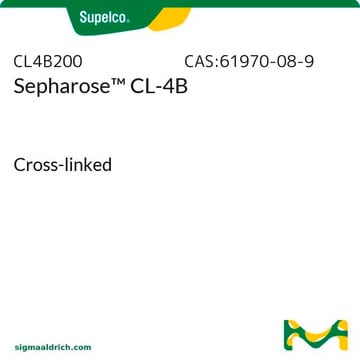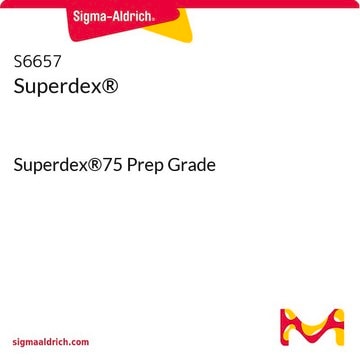6B100
Sepharose™ 6B
6% Beaded Agarose, 45-165 μm (wet), fractionation range 10,000-1,000,000 Da (dextrans)
Synonym(s):
Agarose, Beaded
About This Item
Recommended Products
biological source
algae (marine)
form
suspension
technique(s)
affinity chromatography: suitable
matrix
6% agarose
particle size
45-165 μm (wet)
pore size
10,000-1,000,000 Da fractionation range (dextrans)
10,000-4,000,000 Da fractionation range (globular proteins)
pH
4—9
storage temp.
2-8°C
SMILES string
OC[C@H]1O[C@@H](O[C@@H]2[C@@H]3CO[C@H]2[C@H](O)[C@@H](O3)O[C@H]4[C@@H](O)[C@@H](CO)O[C@@H](O[C@@H]5[C@@H]6CO[C@H]5[C@H](O)[C@H](O)O6)[C@@H]4O)[C@H](O)[C@@H](O)[C@H]1O
InChI
1S/C24H38O19/c25-1-5-9(27)11(29)12(30)22(38-5)41-17-8-4-36-20(17)15(33)24(40-8)43-18-10(28)6(2-26)39-23(14(18)32)42-16-7-3-35-19(16)13(31)21(34)37-7/h5-34H,1-4H2/t5-,6-,7+,8+,9+,10+,11+,12-,13+,14-,15+,16-,17-,18+,19+,20+,21-,22+,23+,24+/m1/s1
InChI key
MJQHZNBUODTQTK-WKGBVCLCSA-N
Looking for similar products? Visit Product Comparison Guide
General description
Other Notes
Legal Information
replaced by
signalword
Warning
hcodes
Hazard Classifications
Flam. Liq. 3
Storage Class
3 - Flammable liquids
wgk_germany
WGK 1
flash_point_f
100.4 - 109.4 °F
flash_point_c
38 - 43 °C
Choose from one of the most recent versions:
Already Own This Product?
Find documentation for the products that you have recently purchased in the Document Library.
Customers Also Viewed
Our team of scientists has experience in all areas of research including Life Science, Material Science, Chemical Synthesis, Chromatography, Analytical and many others.
Contact Technical Service












